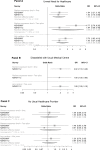Caregiver experiences of racism and child healthcare utilisation: cross-sectional analysis from New Zealand
- PMID: 29572220
- PMCID: PMC6104673
- DOI: 10.1136/archdischild-2017-313866
Caregiver experiences of racism and child healthcare utilisation: cross-sectional analysis from New Zealand
Abstract
Objectives: Children's exposure to racism via caregiver experience (vicarious racism) is associated with poorer health and development. However, the relationship with child healthcare utilisation is unknown. We aimed to investigate (1) the prevalence of vicarious racism by child ethnicity; (2) the association between caregiver experiences of racism and child healthcare utilisation; and (3) the contribution of caregiver socioeconomic position and psychological distress to this association.
Design: Cross-sectional analysis of two instances of the New Zealand Health Survey (2006/2007: n=4535 child-primary caregiver dyads; 2011/2012: n=4420 dyads).
Main outcome measures: Children's unmet need for healthcare, reporting no usual medical centre and caregiver-reported dissatisfaction with their child's medical centre.
Results: The prevalence of reporting 'any' experience of racism was higher among caregivers of indigenous Māori and Asian children (30.0% for both groups in 2006/2007) compared with European/Other children (14.4% in 2006/2007). Vicarious racism was independently associated with unmet need for child's healthcare (OR=2.30, 95% CI 1.65 to 3.20) and dissatisfaction with their child's medical centre (OR=2.00, 95% CI 1.26 to 3.16). Importantly, there was a dose-response relationship between the number of reported experiences of racism and child healthcare utilisation (eg, unmet need: 1 report of racism, OR=1.89, 95% CI 1.34 to 2.67; 2+ reports of racism, OR=3.06, 95% CI 1.27 to 7.37). Adjustment for caregiver psychological distress attenuated the association between caregiver experiences of racism and child healthcare utilisation.
Conclusions: Vicarious racism is a serious health problem in New Zealand disproportionately affecting Māori and Asian children and significantly impacting children's healthcare utilisation. Tackling racism may be an important means of improving inequities in child healthcare utilisation.
Keywords: child; health care utilisation; indigenous; inequities; racism.
© Article author(s) (or their employer(s) unless otherwise stated in the text of the article) 2018. All rights reserved. No commercial use is permitted unless otherwise expressly granted.
Conflict of interest statement
Competing interests: None declared.
Figures

References
-
- United Nations General Assembly. Convention on the Rights of the Child. New York, NY: United Nations, 1990.
Publication types
MeSH terms
LinkOut - more resources
Full Text Sources
Other Literature Sources
Medical
